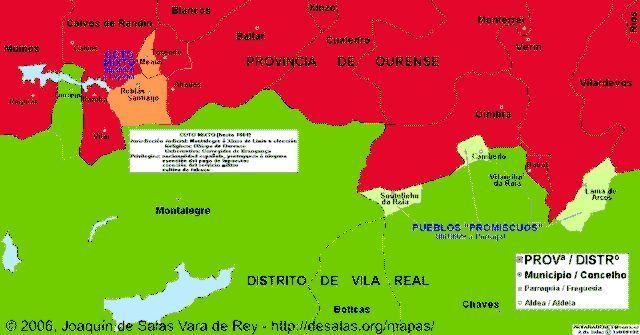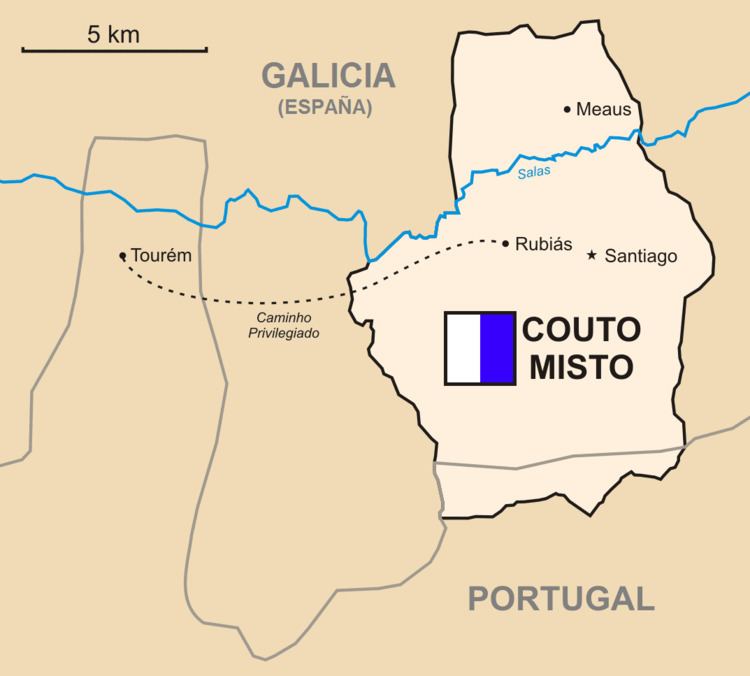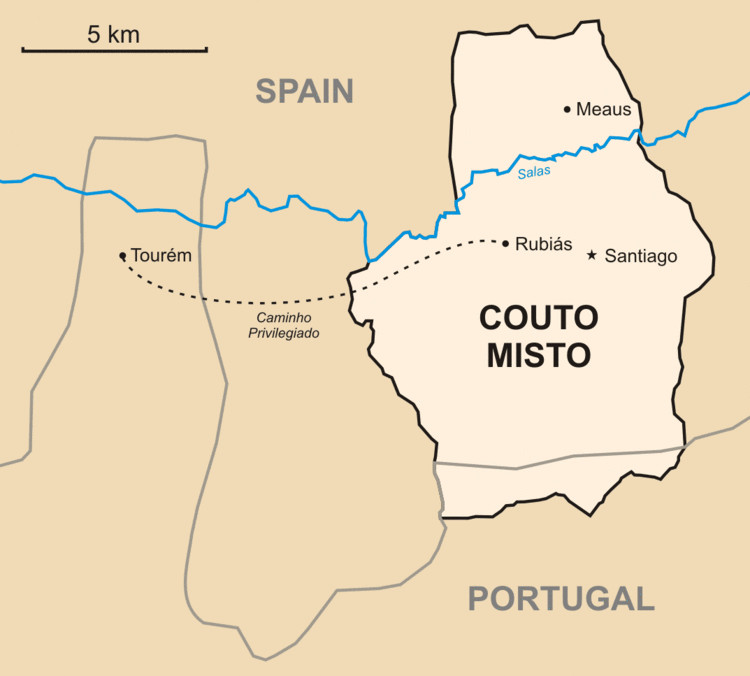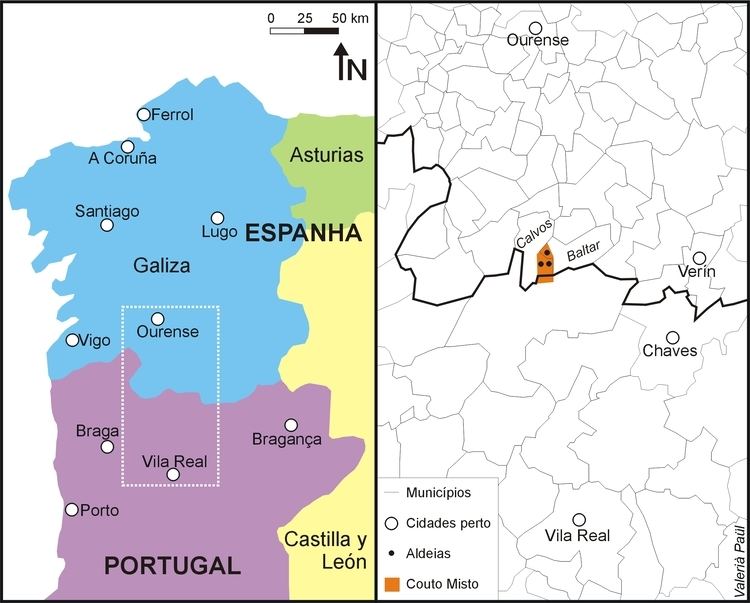Religion Roman Catholic 1845 27 km² (10 sq mi) | Foundation 10th century Area 27 km² | |
 | ||
Languages | ||
Couto Misto (Portuguese: Couto Misto [ˈko(w)tu ˈmiʃtu], Galician: Couto Mixto, Spanish: Coto Mixto) was an independent microstate on the border between Spain and Portugal. It was composed of the villages of Santiago de Rubiás, Rubiás (now in the Spanish municipality of Calvos de Randín), and Meaus (now in the Spanish municipality of Baltar), all located in the Salas Valley, Ourense, Galicia. The territory of the Couto Misto also included a small uninhabited strip now part of the Portuguese municipality of Montalegre.
Contents

As a result of complex medieval manorial relations, this land eluded both Portuguese and Spanish control for centuries, actually operating as a sovereign state of its own right until the 1864 Treaty of Lisbon that partitioned the territory between Spain (which annexed most of the land including the three villages) and Portugal (which remained with a smaller uninhabited strip of land). As a de facto independent country, the inhabitants of the Couto Misto had numerous privileges, including exemption from military service and taxes, and could grant asylum to outsiders and deny access to any foreign military contingent.

Origins

Even though the origins of the Couto Misto remain unclear, the name of this territory is greatly revealing. The term couto (coto in Spanish) comes from the Latin cautes/cautum, which refers generally to an area demarcated with boundary stones (cautos lapideos). According to Ferro Couselo, the term initially referred to the stones used to mark the boundaries of a given territory, but in the Middle Ages it was used to refer to a special set of territories which under the feudal system were exempt from the authority of the King holding a special economical, political and judicial regime. The special jurisdiction of the coutos was maintained through custom and given privileges, sustaining truly independent States within its boundaries that were defended by guards (couteiros).

The adjective misto, meaning "mixed" or "joint", probably refers to the dual manorial links of this territory with the feudal lords from the Duchy of Braganza and the earldom of Monte-Rei. Another interpretation, sustained by oral traditions and some medieval documents (where the terms mystigos or místicos are used, meaning "mystical"), links the origin of the Couto with a myth of a pregnant fugitive princess, allegedly (Saint) Ilduaria Eriz, who found refuge in the villages of this territory and who was to give birth to (Saint) Rudesind Guterri, granting privileges to its inhabitants in gratitude. This explanation may well be based on historical facts, as Ilduaria Eriz, one of the most important Galician aristocrats in the 9th and 10th centuries, had the regions of Limia, where the Couto is located, and what today is northern Portugal under her domains. More so, the birth of Rudesind has actually been placed in the Salas Valley

Several historians have placed the origins of the Couto in the same period of the emergence of the Kingdom of Portugal, somewhere around the 12th century, which is supported by documents that date back to the early 14th century. Initially the Couto was under the jurisdiction of the Piconha Castle (originally Portuguese but now within Spanish territory) but it eventually became tied to the noble houses of Braganza and Monte-Rei. With the extinction of coutos in Portugal, initiated in 1692 and concluded in 1790, the Couto Misto was freed from its feudal ties functioning as a de facto independent state up to its partition and annexation in 1868.
Privileges of Couto Mixto
Current status

As the three villages of the Couto Misto are currently separated in two different municipalities, the main reminiscense of the Couto Misto in the area are the Common land Community Trusts that continue to function in each of the villages under the old system of popular assembly. All three Commons trusts were established in 1976, and incorporate 654 hectares (6.54 km2) for Rubiás, 452 hectares (4.52 km2) for Santiago de Rubiás and 311 hectares (3.11 km2) for Meaus. All together, the commons land represents most of the Couto Misto's territory. The trusts also maintain the claim of rights of common over the strip of land formerly part of the Couto Misto and now part of the Portuguese municipality of Montalegre. A complex legal case over a wind farm at the disputed strip was settled with Enersis, a multinational electric power corporation, with a compensation of €140,000 toward the trusts. Income from the Common land trusts has had significant importance in community development over the past decades.
Outside interest for the Couto re-emerged in the mid-1990s, leading to new research and subsequent academic publications. A joint summer program was organized by the University of Vigo and the University of Trás-os-Montes and Alto Douro in 1999 focusing on the history of the Couto. In 1998 the nonprofit Couto Misto Friendship Association (Asociación de Amigos do Couto Mixto) was established, followed in 2003 by the Couto Misto Community Association (Asociación de Veciños do Couto Mixto). Both organizations have reestablished the figure of the Homens de Acordo, with one person representing each of the villages, and also that of the Juiz Honorário (Honorary Judge) which is named each year in a ceremony held in the church of Santiago. The Chest of the Three Keys has also been restored with each of the keys being kept under the custody of the current Homens de Acordo.
Political moves regarding the Couto Misto have led to debates and resolutions in the Galician, Spanish and European Parliaments. In May 2007, a motion (Proposición no de ley) was discussed and approved (with 303 votes in favour) by the Spanish Parliament recognizing the singularity of the Couto Mixto as a historical and cultural enclave and calling for measures that allow for the social and economical development of the territory. At the same time a similar motion was approved by the Galician Parliament, also recognizing the historical singularity of the Couto. In 2008, a written question was presented at the European Parliament regarding the European Union's contribution to the revival of the Couto Mixto, defined as an "institution which was politically and administratively independent of the Spanish and Portuguese crowns". In 2016, a request was made for the inhabitants of the Couto be granted Portuguese and Spanish dual citizenship following the previous case of Olivenza.
